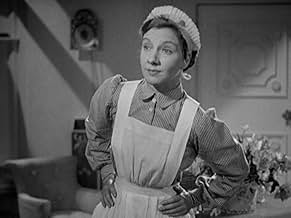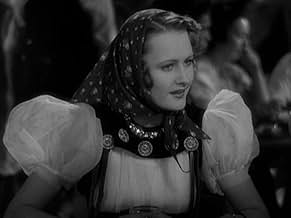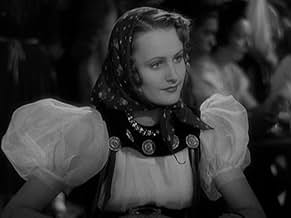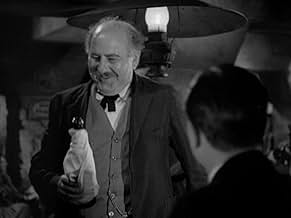NOTE IMDb
6,3/10
1,3 k
MA NOTE
Ajouter une intrigue dans votre langueA lounge singer is sent by a count to pose as a wealthy socialite.A lounge singer is sent by a count to pose as a wealthy socialite.A lounge singer is sent by a count to pose as a wealthy socialite.
- Réalisation
- Scénario
- Casting principal
Mary Philips
- Maria
- (as Mary Phillips)
Rafael Alcayde
- Hotel Clerk
- (non crédité)
Nino Bellini
- Cosmos Club Waiter
- (non crédité)
Agostino Borgato
- Cordellera Bar Waiter
- (non crédité)
Adriana Caselotti
- First Peasant Girl
- (non crédité)
Robert Cauterio
- Hotel Clerk
- (non crédité)
Irene Coleman
- Cosmos Club Hat Check Girl
- (non crédité)
Gino Corrado
- Cosmos Club Croupier
- (non crédité)
Avis à la une
Jaded club singer Anni Pavlovitch (Joan Crawford) runs into a count who devises a plan to give Anni an opportunity to swing with the swells for two weeks in a rustic Italian vacation spot in the mountains. Anni is totally seduced by the lifestyle and with time running out moves in on Maddelena Monti' s well heeled beau Rudi Pal ( Robert Young) to try an insinuate herself into the jet set lifestyle on a more permanent basis. The local postman Giullio (Franchot Tone) has also taken a shine to Anni offering her an unencumbered down to earth existence in contrast but cynical Anni is tired of the hardscrabble existence preferring pampered materialism instead.
Under the rare oddity of a female studio film director (Dorothy Arzner) Crawford is allowed to stretch with more than satisfying results as she struggles with the conflict of hooking up for love or money. Arzner not only gets some impressive long takes out of Crawford but also softens her standard studio brusqueness with a touching sensitivity as her dream of easy street evaporates before her eyes.
Arzner also gets fine performances out of upper crusts played by Young and a beautifully smug performance from Billie Burke without being condescending to such easy targets. The real surprise though is the sophisticated Franchot Tone as Giullio the country postman. Playing it neither broad or passionate Tone subversively bides his time with a dignity and patience that gives The Bride Wore Red a nice subtle edge and a more touching denouement.
Under the rare oddity of a female studio film director (Dorothy Arzner) Crawford is allowed to stretch with more than satisfying results as she struggles with the conflict of hooking up for love or money. Arzner not only gets some impressive long takes out of Crawford but also softens her standard studio brusqueness with a touching sensitivity as her dream of easy street evaporates before her eyes.
Arzner also gets fine performances out of upper crusts played by Young and a beautifully smug performance from Billie Burke without being condescending to such easy targets. The real surprise though is the sophisticated Franchot Tone as Giullio the country postman. Playing it neither broad or passionate Tone subversively bides his time with a dignity and patience that gives The Bride Wore Red a nice subtle edge and a more touching denouement.
The Bride Wore Red is a ridiculous but fun film. A drunken count, slumming it for the night, runs into a cynical and hungry young woman, Anni Pavlovitch (Joan Crawford). He decides to send her on a luxury vacation to prove his drunken point that the poor and the rich aren't so different after all and buys her new clothes and arranges for her to stay in a luxury resort. Anni, who obviously thinks the whole thing is crazy, decides to go threw with it anyway. Arriving in the alps she meets Giulio (Crawford's real life husband, Franchot Tone) a very pert mail employee who immediately takes a shine to her. The two have sparks aplenty, but when she arrives at the hotel Anni quickly realizes that she would rather always have food on her table than the love of a good man, and quickly sets about seducing Rudi, a flighty engaged man who is very taken with her.
As with most romcoms the real test is if the chemistry works and here it does perfectly. Crawford and Tone have excellent chemistry here and he is very sweet and naive, persistently wearing down the jaded and bitter singer.
It's a lovely sweet film.
As with most romcoms the real test is if the chemistry works and here it does perfectly. Crawford and Tone have excellent chemistry here and he is very sweet and naive, persistently wearing down the jaded and bitter singer.
It's a lovely sweet film.
In about 1980 I saw this film at the UCLA Film Archives in a series presenting Dorothy Arzner directed films. There was a guest speaker at the event who was a personal friend of Arzner's. I don't remember her name, but she was introduced as, among other things, the writer for the script of "Craig's Wife" (1936; starring Rosalind Russell).
She said she was on the set for some of the shooting of "Bride Wore Red," and described how Joan Crawford was completely uncooperative with the director. Originally it was written for Luise Rainer but for some reason she was unavailable. "So they got Joan Crawford who wasn't anything like her," and was not suited for the film in this woman's opinion. While she was on the set she witnessed how Dorothy Arzner would gently make suggestions as to how to play a scene, "...and Joan would scream, 'You'll destroy me! You'll destroy me!' and she would run up to L.B. Mayer and he would say, 'There, there Joan, play it your way." So she did, "...and frankly, the film bombed. But when you have a star that is entirely uncooperative, you can't blame the director." I hope I have quoted this woman accurately. That is what has stuck in my memory. I am a big Crawford fan, but her flaws were apparently spectacular. I just thought it would be interesting to record this bit of info.
She said she was on the set for some of the shooting of "Bride Wore Red," and described how Joan Crawford was completely uncooperative with the director. Originally it was written for Luise Rainer but for some reason she was unavailable. "So they got Joan Crawford who wasn't anything like her," and was not suited for the film in this woman's opinion. While she was on the set she witnessed how Dorothy Arzner would gently make suggestions as to how to play a scene, "...and Joan would scream, 'You'll destroy me! You'll destroy me!' and she would run up to L.B. Mayer and he would say, 'There, there Joan, play it your way." So she did, "...and frankly, the film bombed. But when you have a star that is entirely uncooperative, you can't blame the director." I hope I have quoted this woman accurately. That is what has stuck in my memory. I am a big Crawford fan, but her flaws were apparently spectacular. I just thought it would be interesting to record this bit of info.
Joan Crawford stars in "The Bride Wore Red," a 1937 MGM film based on the play by Ferenc Molnar. Here, it's directed by Dorothy Arzner. Arzner was a fascinating woman - a female director amid a sea of men - very much ahead of her time in her dress, profession, and lifestyle, and highly intelligent. Was she a great director? Hard for me to say. I don't think she always got the best scripts. And in Crawford, she had a headstrong star as well.
The story concerns a poor girl, Anni (Crawford) who sings in a sleazy café (read: with prostitution as a sideline)in the red light district of Trieste. A count she meets believes that the only thing separating the rich from the poor is money - it's not class, it's not breeding, it's not education. To make his point, he sends Anni to a fabulous resort with beautiful new clothes for two weeks. Anni meets Rudi (Robert Young), from an excellent and wealthy family, but he's engaged. With time short, Anni decides that it's Rudi she wants, and is determined to stick it out as long as necessary to get him. But it's not only a lack of funds and Rudi's fiancé standing in her way - it's also the postman, Giulio (Franchot Tone).
Crawford is beautiful, and this was the type of role she played continuously in the 1930s with great success. Tone, Young, and Billie Burke give her good support.
What is this business with the "no European accents" that someone mentioned? Actors do not use European accents when portraying foreigners in their own country or a nearby country. The characters aren't speaking English with a foreign accent in Poland, Switzerland, or Italy. They're speaking another language. If accents were necessary, all Chekov plays would be done with Russian accents. They aren't.
I thought for what this was, the film took a little too long to make its point and was a bit slow in spots. It's not the best Crawford film, but she gives a strong performance as a willful woman determined to marry money. As for Arzner's direction, apparently she couldn't get anywhere with Crawford, so I'll withhold judgment.
The story concerns a poor girl, Anni (Crawford) who sings in a sleazy café (read: with prostitution as a sideline)in the red light district of Trieste. A count she meets believes that the only thing separating the rich from the poor is money - it's not class, it's not breeding, it's not education. To make his point, he sends Anni to a fabulous resort with beautiful new clothes for two weeks. Anni meets Rudi (Robert Young), from an excellent and wealthy family, but he's engaged. With time short, Anni decides that it's Rudi she wants, and is determined to stick it out as long as necessary to get him. But it's not only a lack of funds and Rudi's fiancé standing in her way - it's also the postman, Giulio (Franchot Tone).
Crawford is beautiful, and this was the type of role she played continuously in the 1930s with great success. Tone, Young, and Billie Burke give her good support.
What is this business with the "no European accents" that someone mentioned? Actors do not use European accents when portraying foreigners in their own country or a nearby country. The characters aren't speaking English with a foreign accent in Poland, Switzerland, or Italy. They're speaking another language. If accents were necessary, all Chekov plays would be done with Russian accents. They aren't.
I thought for what this was, the film took a little too long to make its point and was a bit slow in spots. It's not the best Crawford film, but she gives a strong performance as a willful woman determined to marry money. As for Arzner's direction, apparently she couldn't get anywhere with Crawford, so I'll withhold judgment.
The Bride Wore Red is based on an unpublished Ferenc Molnar play which he probably couldn't get anyone on Broadway interested in. So for a reduced rate he sold the property to MGM which gave it the usual lavish MGM treatment.
American accents which bothered some other reviewers didn't bother me. Sometimes they stand out, sometimes they don't. In this case Joan Crawford was cast in a role she played dozens of times before as the poor girl given a chance at riches and does she grab.
This variation on the Pygmalion theme starts in a café in Trieste where Crawford sings and presumably will do other things for her supper. It's in the red light district of Trieste. Count George Zucco hires her on a whim to prove that clothes and manner do make the individual. Zucco showers Crawford with a new wardrobe giving her the chance to show off those Adrian gowns and gives her two weeks at a resort in the Tyrol where the high society pleasures itself.
To make this last though Crawford has to land a husband and she lands on Robert Young. But he's slightly engaged to Lynne Carver, a sweet young thing. They're traveling with friends Reginald Owen who is a foxy old rogue and married to Billie Burke who has to watch the fox like a hawk.
The local postman Franchot Tone is interested in her, but Crawford figures to do better than him. Her only friend is a former café colleague in Mary Phillips who is working as a maid in that hotel. Though the experiment is Pygmalion like, Crawford feels more like Cinderella with the clock inevitably ticking towards midnight.
I think you can probably figure out where this all ends if you're any kind of film fan and Crawford fan. Dorothy Arzner's direction sharpens the character that Crawford created in Grand Hotel as an anxious to rise stenographer taking her couple of steps lower in society and seeing if she can make the climb.
Franchot Tone who was married to Joan Crawford at the time got a break of sorts in this film. Normally he'd be the society guy who Crawford is trying for. As the common, but somewhat erudite postman for once he's not in formal wear in a film.
Another surprise is Billie Burke who together with Mary Boland and Spring Byington was busy playing delightful airheads in her film. She's quite serious and quite good, but inevitably went back to being typecast after this film was completed.
The Bride Wore Red will please Joan Crawford fans immensely and this is a most typical example of the kind of character she played in her years at MGM.
American accents which bothered some other reviewers didn't bother me. Sometimes they stand out, sometimes they don't. In this case Joan Crawford was cast in a role she played dozens of times before as the poor girl given a chance at riches and does she grab.
This variation on the Pygmalion theme starts in a café in Trieste where Crawford sings and presumably will do other things for her supper. It's in the red light district of Trieste. Count George Zucco hires her on a whim to prove that clothes and manner do make the individual. Zucco showers Crawford with a new wardrobe giving her the chance to show off those Adrian gowns and gives her two weeks at a resort in the Tyrol where the high society pleasures itself.
To make this last though Crawford has to land a husband and she lands on Robert Young. But he's slightly engaged to Lynne Carver, a sweet young thing. They're traveling with friends Reginald Owen who is a foxy old rogue and married to Billie Burke who has to watch the fox like a hawk.
The local postman Franchot Tone is interested in her, but Crawford figures to do better than him. Her only friend is a former café colleague in Mary Phillips who is working as a maid in that hotel. Though the experiment is Pygmalion like, Crawford feels more like Cinderella with the clock inevitably ticking towards midnight.
I think you can probably figure out where this all ends if you're any kind of film fan and Crawford fan. Dorothy Arzner's direction sharpens the character that Crawford created in Grand Hotel as an anxious to rise stenographer taking her couple of steps lower in society and seeing if she can make the climb.
Franchot Tone who was married to Joan Crawford at the time got a break of sorts in this film. Normally he'd be the society guy who Crawford is trying for. As the common, but somewhat erudite postman for once he's not in formal wear in a film.
Another surprise is Billie Burke who together with Mary Boland and Spring Byington was busy playing delightful airheads in her film. She's quite serious and quite good, but inevitably went back to being typecast after this film was completed.
The Bride Wore Red will please Joan Crawford fans immensely and this is a most typical example of the kind of character she played in her years at MGM.
Le saviez-vous
- AnecdotesDuring filming, an electrician fell from the catwalk high above the set, narrowly missing the film's star, Joan Crawford. Shooting was temporarily halted while the man was rushed to hospital. Crawford refused to resume production until she was assured that the man would be fully cared for, that he would remain on salary, and that his family would be provided for. Crawford also called the hospital each day afterwards for reports on his condition.
- Citations
Rudolph 'Rudi' Pal: In my opinion, most people prefer sardines to caviar because most people haven't tried caviar.
- Crédits fousDuring the opening credits, a music box is shown playing a tune in the background.
- ConnexionsFeatured in The Romance of Celluloid (1937)
- Bandes originalesWho Wants Love?
(1937)
Music by Franz Waxman
Lyrics by Gus Kahn
Sung by Joan Crawford (uncredited) at the Cordellera Bar
Played throughout as part of the score
Meilleurs choix
Connectez-vous pour évaluer et suivre la liste de favoris afin de recevoir des recommandations personnalisées
- How long is The Bride Wore Red?Alimenté par Alexa
Détails
- Date de sortie
- Pays d’origine
- Langue
- Aussi connu sous le nom de
- The Bride Wore Red
- Lieux de tournage
- Autriche(Alpine exteriors)
- Société de production
- Voir plus de crédits d'entreprise sur IMDbPro
Box-office
- Budget
- 960 000 $US (estimé)
- Durée
- 1h 43min(103 min)
- Couleur
- Rapport de forme
- 1.37 : 1
Contribuer à cette page
Suggérer une modification ou ajouter du contenu manquant




































